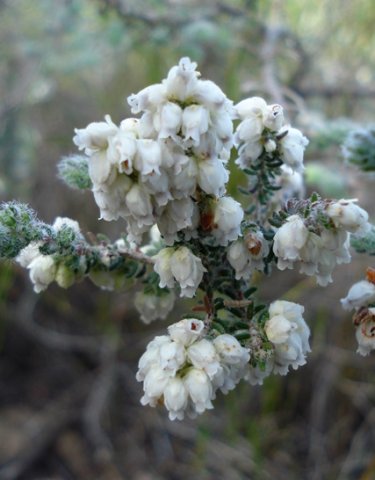Erica totta

Author: Ivan Lätti
Photographer: Judd Kirkel Welwitch
Erica totta, previously scientifically known as Eremia totta, is a much-branched, matforming or spreading shrublet reaching about 30 cm in height and 1 m in diameter. It is unknown what made Carl Thunberg choose that specific name, totta, so long ago; today an obscure word.
The needle-like leaves grow in whorls of three. They are greyish from a minute hair covering, as well as white bristly hairs on lower surfaces and margins.
The stalkless or short-stalked flowers grow in a whorl or two on most of the numerous, erect side-branchlets, aggregating in dense clusters. Flower fragrance is sourish. The white, basally inflated corollas have small, white, papery bracteoles pressed against their back ends and large, white, elliptic sepals covering about two thirds of each corolla, leaving open only the four protruding petal lobes, slightly diverging to erect. The sepals may be slightly hairy but notably hair-fringed. The urn-shaped corollas have four petal keels low down and are mostly hairless or only slightly hairy. The corollas are from 2,5 mm to 4 mm long. The flowers may turn brown early. The eight anthers are rounded at the base and included in their corolla. The style ending in a pinhead stigma is marginally exserted.
Bloomtime is late winter to early summer. The brittle or papery fruits do not dehisce.
The species distribution is in the southwest of the Western Cape, from around the Cederberg to Somerset West. The photo was taken near Tulbagh.
The habitat is rocky fynbos mountain slopes in sandstone. The habitat population is deemed of least concern early in the twenty first century (Manning and Helme, 2024; iNaturalist; JSTOR; http://redlist.sanbi.org).

